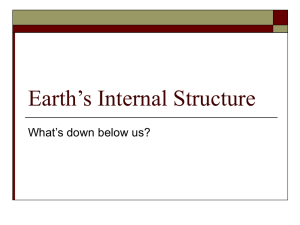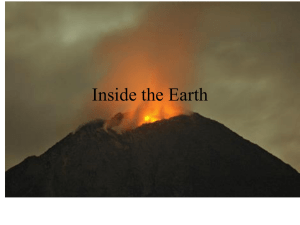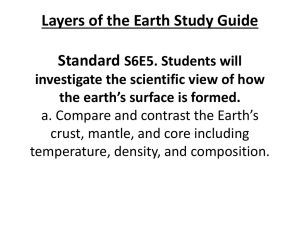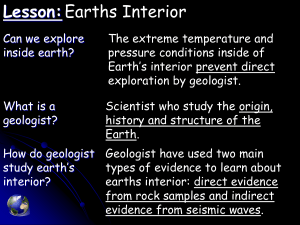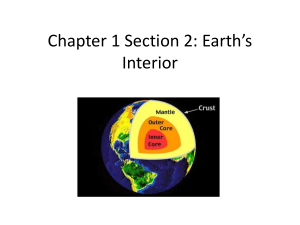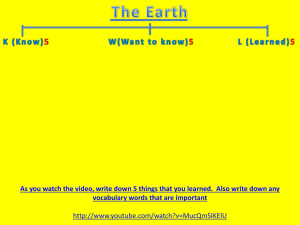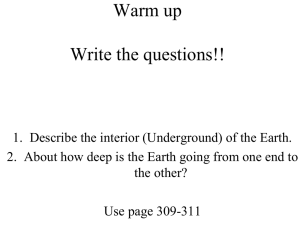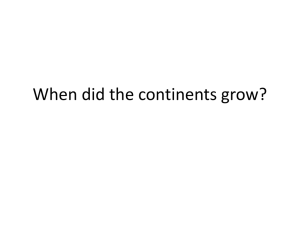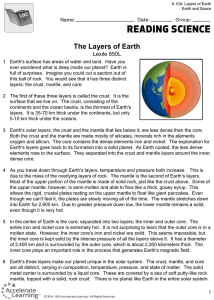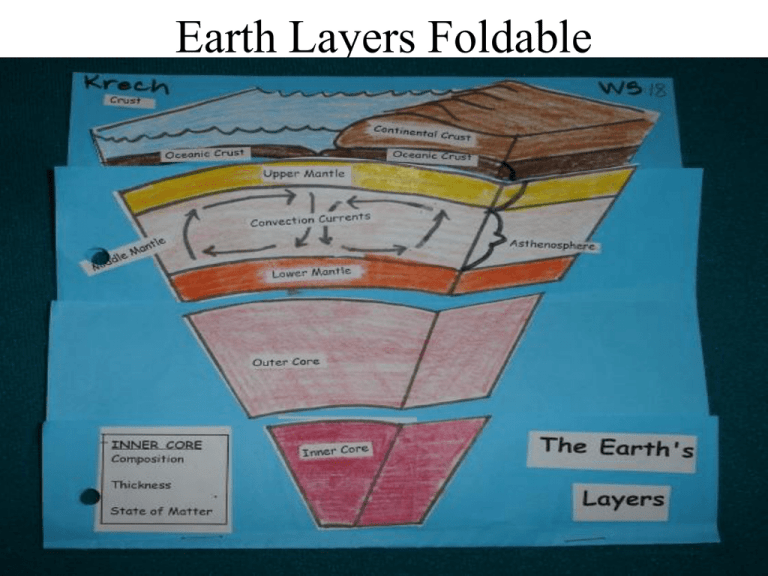
Earth Layers Foldable
The Layers of the Earth
© Copyright 2006. M. J. Krech. All rights reserved.
The Four Layers
The Earth is composed of four
different layers. The crust is
the layer that you live on, and
it is the most widely studied
and understood. The mantle
is much hotter and has the
ability to flow. The outer
core and inner core are
even hotter with pressures so
great you would be squeezed
into a ball smaller than a
marble if you were able to go
to the center of the Earth!
The Crust
The Earth's Crust is like the
skin of an apple. It is very thin
in comparison to the other
three layers. The crust is only
about 3-5 miles (8 kilometers)
thick under the oceans
(oceanic crust) and about 25
miles (32 kilometers) thick
under the continents
(continental crust).
The crust is composed of two rocks. The continental
crust is mostly granite. The oceanic crust is basalt.
Basalt is much denser than the granite. Because of this
the less dense continents ride on the denser oceanic
plates.
The Lithosphere
The crust and the upper layer of the
mantle together make up a zone of rigid,
brittle rock called the Lithosphere.
The Lithospheric Plates
The crust of the Earth is broken into many pieces called
plates. The plates "float" on the soft, semi-rigid
asthenosphere.
The Asthenosphere
The asthenosphere
is the semi-rigid
part of the middle
mantle that flows
like hot asphalt
under a heavy
weight.
The Mantle
The Mantle is the
largest layer of the Earth
at 2900 km thick. The
middle mantle is
composed of very hot
dense rock that flows like
asphalt under a heavy
weight. The movement of
the middle mantle
(asthenosphere) is the
reason that the crustal
plates of the Earth move.
Convection Currents
The middle mantle "flows" because of convection
currents. Convection currents are caused by the very hot
material at the deepest part of the mantle rising, then
cooling and sinking again --repeating this cycle over and
over.
The Outer Core
The core of the Earth
is like a ball of very
hot metals. The
outer core
is so
hot that the metals in
it are all in the liquid
state. The outer core
is composed of the
melted metals of
nickel and iron.
The Inner Core
The inner core of
the Earth has
temperatures and
pressures so great that
the metals are
squeezed together and
are not able to move
about like a liquid, but
are forced to vibrate in
place like a solid.
Layers of the
Earth
• How far have scientists drilled into the
earth?
• 7.6 miles
– Only 0.2% of the distance to the earth’s
core
How do we know so much about
what’s under Earth’s surface?
• Through INDIRECT EVIDENCE, mostly
from seismic waves caused by earthquakes
(more on this later this semester...)
• Sometimes indirect evidence is the only option
for scientists to develop a theory
• Lets give it a try...
Earth’s 4 main Layers
•
•
•
•
Crust
Mantle
Outer Core
Inner Core
The Crust
• The crust, the outermost layer, is rigid and
very thin
• Oceanic Crust (beneath the ocean) is about
5 km thick
• Continental Crust (under land) averages
about 30 km and 100 km deep.
• Like the shell of a hardboiled egg
Mantle
• The Mantle is a dense, hot layer of semisolid rock approximately 2,900 km thick.
• The mantle contains more iron, magnesium,
and calcium than the crust
• is hotter and denser because temperature
and pressure inside the Earth increase with
depth.
• As a comparison, the mantle might be
thought of as the white of a boiled egg.
The Crust
• the core, is nearly twice as dense as the
mantle because its composition is metallic
(iron-nickel alloy).
• the Earth's core is made up of two distinct
parts:
– a 2,200 km-thick liquid outer core
– a 1,250 km-thick solid inner core
– As the Earth rotates, the liquid outer core spins,
creating the Earth's magnetic field.
The Lithosphere
• Lithosphere =
the crust and the
uppermost part
of mantle
The Asthenosphere
• Asthenosphere = the fluid like portion of the
mantle that lies just below lithosphere. The
lithosphere “floats” on the asthenosphere
Practice Quiz Question
• Can you label the following layers?


